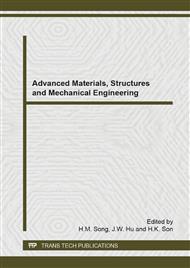p.656
p.661
p.668
p.672
p.677
p.683
p.688
p.693
p.697
Acid Value Reduction Process in Mixed Crude Palm Oil by Using Low-Grade Ethanol
Abstract:
In Thailand, the ethanol production was produced from factory fermentation of many food crops such as sugar cane, molasses, and cassava. Thus, this alcohol is not required to be imported from abroad. Moreover, the advantages of ethanol over methanol are less toxic, and the fatty acid ethyl ester (FAEE) has higher heat content, cetane number and lower cloud point, pour point than the fatty acid methyl esters (FAME). In this study, the 95% commercial ethanol (as a low-grade ethanol) was used to reduce the acid value in the mixed crude palm oil (MCPO). The Response surface methodology (RSM), a 5-level 2-factor central composite design (CCD), was employed to optimize the ethanol, and sulfuric acid. The results showed that the 95% ethanol can reduced the acid value from 34.5 mgKOH/g to less than 2 mgKOH/g. Therefore, the esterified oil can be used to produce biodiesel by base-catalyzed transesterification when the optimal condition: 81.3 vol.% ethanol, 10 vol.% sulfuric acid, and 75°C reaction temperature are used. Moreover, the acid value in MCPO was sharply reduced to less than 7.477 mgKOH/g at 5 min, and to less than 1.621 mgKOH/g after 30 min of reaction time when the model of optimal condition was verified.
Info:
Periodical:
Pages:
677-682
Citation:
Online since:
September 2014
Price:
Сopyright:
© 2014 Trans Tech Publications Ltd. All Rights Reserved
Share:
Citation:


